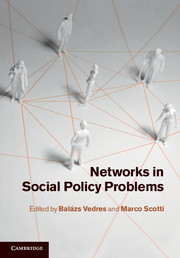Book contents
- Frontmatter
- Contents
- List of contributors
- Acknowledgements
- 1 Introduction
- Part I Information, collaboration, innovation: the creative power of networks
- Part II Influence, capture, corruption: networks perspectives on policy institutions
- Part III Crisis, extinction, world system change: network dynamics on a large scale
- 10 How creative elements help the recovery of networks after crisis: lessons from biology
- 11 Networks and globalization policies
- 12 Network science in ecology: the structure of ecological communities and the biodiversity question
- 13 Supply security in the European natural gas pipeline network
- 14 Conclusions and outlook
- References
- Index
14 - Conclusions and outlook
from Part III - Crisis, extinction, world system change: network dynamics on a large scale
Published online by Cambridge University Press: 05 September 2012
- Frontmatter
- Contents
- List of contributors
- Acknowledgements
- 1 Introduction
- Part I Information, collaboration, innovation: the creative power of networks
- Part II Influence, capture, corruption: networks perspectives on policy institutions
- Part III Crisis, extinction, world system change: network dynamics on a large scale
- 10 How creative elements help the recovery of networks after crisis: lessons from biology
- 11 Networks and globalization policies
- 12 Network science in ecology: the structure of ecological communities and the biodiversity question
- 13 Supply security in the European natural gas pipeline network
- 14 Conclusions and outlook
- References
- Index
Summary
Network science: roots and perspectives
Graphite is a soft, easy to break material, whose physical properties are rooted in the weak coupling between the layers its atoms form. In contrast diamond, whose atoms are arranged in a face-centered cubic lattice, is the hardest material we know on Earth. But the same atoms can also form a hollow sphere, called buckyball, or a cylinder that goes by the name of carbon nanotube. These materials have such fascinating chemical properties that their discovery was honored with a chemistry Nobel Prize in 1996. When these atoms form stacked sheets of linked hexagonal, pentagonal, or heptagonal rings, we call them graphene, with their own impressive list of properties and potential applications, from nano-transistors to gas detectors, a reason why this material swept the 2010 physics Nobel Prize.
What is fascinating about this list is that each of these materials, with such diverse appearance and physical and chemical characteristics, is made of the same atom: carbon. Yet, at the end there is only one difference between graphite, graphene, diamond, buckyballs, carbon nanotubes, and many other allotropes of carbon: the shape of the network that links the carbon atoms to each other. Which is an observation that increasingly resonates well beyond physics and chemistry: when it comes to the society, the economy, or even our cells, some tough, others malleable, some alive while others barely hanging on, many of their characteristics are rooted in the structure of the network that waves their building blocks together.
- Type
- Chapter
- Information
- Networks in Social Policy Problems , pp. 265 - 268Publisher: Cambridge University PressPrint publication year: 2012



